Pain effectively treated by scalp acupuncture!

Dr. Toshikatsu Yamamoto, M.D., Ph.D.
Yamamoto New Scalp Acupuncture can also appreciably improve paralysis and speech disorders after strokes.
T. Yamamoto, Th. Schockert
Yamamoto New Scalp Acupuncture is a fast and easy-to-learn method amongst other applications for the treatment of acute strokes and represents a valuable complement to conventional schemes of treatment. Therapy should be initiated by the emergency doctor, continued during treatment at the hospital and stroke unit and, if necessary, extended beyond the rehabilitation phase by the patient’s family doctor.
The Yamamoto New Scalp Acupuncture method was first published in 1973 and has been continuously extended and supplemented ever since.
Above all, pain and motor disturbances of the locomotor system and pareses of the extremities are treated by basic points.
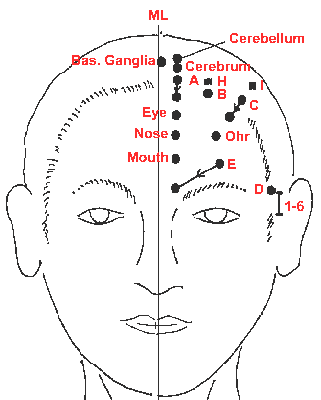
A – subdivided 1-7, cervical spine
B – shoulder, neck
C – subdivided 1-6, shoulder joint, upp. arm, elbow, low. arm, wrist, hand, fingers
D – subdivided 1-6, lumbar spine/sacrum,
low. extremities
E – subdivided 1-12, chest, thoracic spine
H – lumbago
I – ischiadic nerve
All illustrations are taken from Helene and Toshikatsu Yamamoto and some of them can be found in their current textbook published by Springer-Verlag, Japan, (see below).
Internal diseases are mainly treated by needle acupuncture of the so-called Y points in the temple region. These Y points have been known since 1980.
Aphasia Points are not Y-Points, but care demonstrated here because of their position. It is of special interest that Broca´s aphasia is treated with the Yin Point, and Wernicke´s aphasia with the Yang Point
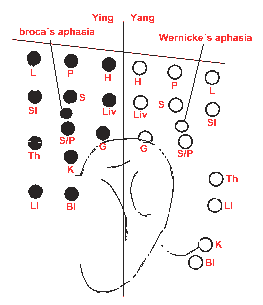 L = lungs
L = lungs
Liv = liver
H = heart
P = pericardium
G = gall bladder
SI = small intestine
S/P = spleenpancreas
Th = triple heater
S = stomach
D = duodenum
LI = large intestine
K = kidney
BlI = bladder
B = brain
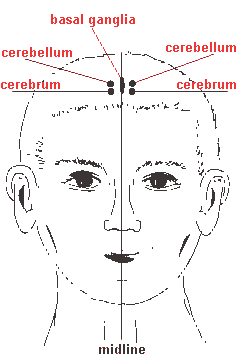
Finally, the brain points discovered in 1995 as well as the aphasia points have provided additional possibilities of treating strokes.
YNSA Brain Points in the Yin position. The Basal Ganglia Point is elongated between the Cerebrum Point and the Cerebellum Point, extending slightly more posteriorly than the other two Brain Points.
In the meantime, Dr Yamamoto has discovered other somatotopes which still remain to be published. The points of different somatotopes mutually complement and reinforce each other. They can be combined with each other as required.
Needles are applied daily to patients suffering from apoplectic stroke for a period ranging from three weeks to three months. If necessary, the therapy can be extended by a further three months.
The aim of YNSA is a restitutio ad integrum. Paralysis and aphasia will recede completely, especially if therapy is initiated in good time.
YSNA has also proved very successful in treating the following disorders:
- all kinds of motor disturbances, hemiplegia, paraplegia, migraine, trigeminal neuralgia,
- Parkinson’s disease, MS, endocrine disturbances, vertigo, tinnitus, aphasia, impaired vision, dementia,
- Alzheimer’s disease, epilepsy, insomnia, depression and other psycho-neurological disorders.
If the efficiency of body acupuncture is compared to a pebble thrown into a lake then scalp acupuncture can be compared to a paving stone thrown into a garden pond since applying needles, for example, to a Y point influences the entire meridian assigned to it.
The earlier therapy begins, the faster and more effective is its success. However, even if months or years have elapsed between the stroke and the start of therapy, the patient’s condition can still be considerably improved.
Diagnosis of the Neck and Abdomen
Therapy usually starts with the basic points. The therapist decides which Y points are to be used after palpitating the diagnostic zones on the neck and abdomen. The sensitivity to pressure of the diagnostic area recedes immediately after applying the needles to the corresponding acupuncture point if the needles are positioned correctly.
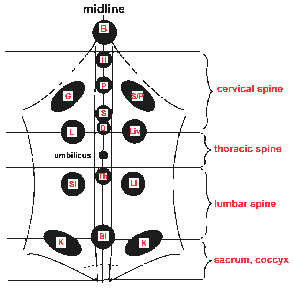
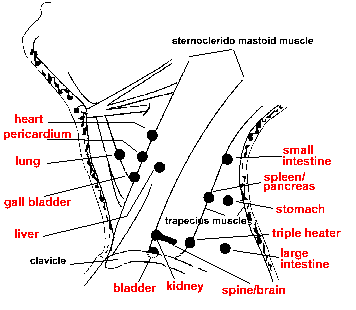
YNSA neck diagnostic zones / areas.
All neck diagnostic areas are bilateral
L = lungs
Liv = liver
H = heart
P = pericardium
G = gall bladder
SI = small intestine
S/P = spleenpancreas
Th = triple heater
S = stomach
D = duodenum
LI = large intestine
K = kidney
BlI = bladder
B = brain
The neck and abdomen are thus suitable for diagnostic purposes as well as for an immediate check on the progress of treatment. This is absolutely new and unique in the history of acupuncture since the perfect position of the needles can now be monitored
From the ethical perspective, on the basis of present experience the benefits of YNSA should no longer be withheld from stroke patients. To the end, physicians must be trained as rapidly and intensively as possible. The greatest priority should be given to training all neurological and internal specialists, as well as doctors employed in the rescue services. As a complement to the therapeutic guidelines described in the „Ärzteblatt“ (Physicians‘ Gazette) no. 17/1999, as an immediate therapeutic measure YNSA would have an extremely positive influence on the prognosis for acute strokes. In the case of patients unable to be treated by lysis therapy, YNSA should be initiated by the emergency doctor. Furthermore, YSNA must become an integral part of basic therapy at all stroke units. The basic principles of YNSA can be learned in a few days, after which any medical therapist can apply efficient treatment. As yet, data are only available on stroke therapy via the basic points. There is a lack of studies investigating the success rate of the extended therapy via basic, Y and brain points. Scalp acupuncture treats sensorimotor deficiency, regulates body temperature, and reinforces and supports the effectiveness of all other conventional measures. YNSA encourages blood circulation and has a neuroprotective effect; in acute cases the success of treatment often becomes apparent after just a few minutes.
Statistics
Because there are very few statistics and experiments, the success of treatment with patients is presented as evidence.
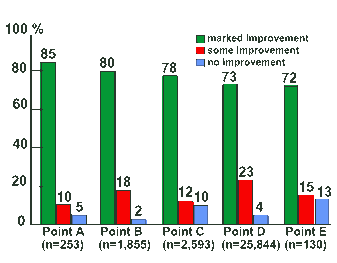
Fig. 1 YNSA Basic Points used for pain relief
Many thermographs were taken but not analyzed statistically. Some of the thermographs can be seen with the patient presentations on previous pages.
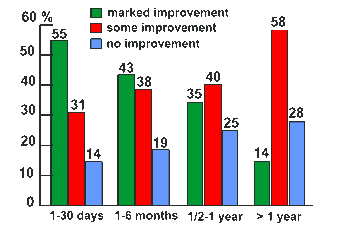
Fig. 2 Time-related results with YNSA Basic Points.
All thermographs were taken after the patient had been in the same room at constant temperature for about 30 minutes: first before YNSA, then during treatment, and again approximately 5 minutes after withdrawal of the acupuncture needles. Most patients showed a temperature increase, evidence of improved blood circulation. When acupuncture was used for pain relief, there was often an increased temperature at the site of pain before acupuncture which subsided after YNSA treatment.
Brunnstorm stage, an internationally recognized measure of movement in hemiplegic patients, has also been used and shown in graphs with the patient presentations.
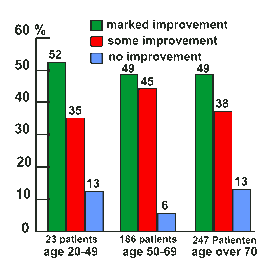
Fig. 3 Age-related effect of YNSA for hemiplegic patients.
Some statistics were compiled for patients treated with YNSA Basic Points for pain relief and hemiplegia. Although statistics have not been compiled since the use of Y-Points, an even higher level of improvement is certain.
In Figure 1, the high success rate of pain relief is clearly seen. With Basic Points A, B, C, D, and E the green column shows almost total pain relief.
The graphs in Figures 2, 3 and 4 show some statistics relating to stroke patients after treatment with only YNSA Basic Points.
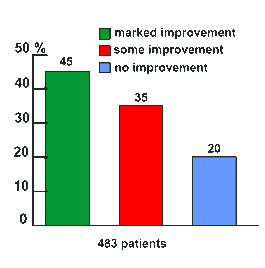
Fig. 4 Combination of YNSA Basic C and D Points.
As can be seen, treatment success is not limited by age. It is important to start acupuncture treatment as soon as possible after the stroke.
Dr Yamamoto holds YNSA courses at his clinic and rehabilitation centre in Japan. In Germany, amongst others the DÄGfA (German Medical Society for Acupuncture) holds courses in.
Information on short team training courses for hospitals and rehabilitation centres can be obtained from
thomas.schockert@gmail.com (Please contact us in english or german language)
Dr Yamamoto’s YNSA courses are extremely interesting. His slides and films showing the progress of treatment for paralysed patients up to complete recovery are especially exciting and impressive. Dr Yamamoto is not only an expert teacher, he is also a resourceful researcher; he treats patients, instructs physicians and performs research with infectious humour and enthusiasm!

Dr Toshikatsu Yamamoto and his wife with participants at a seminar for doctors at Miyazaki, Japan, in October 2003.

Dr Toshikatsu Yamamoto and his wife with participants at a seminar for doctors at Miyazaki, Japan, in October 2004.

Dr Toshikatsu Yamamoto with participants at a seminar for doctors at Miyazaki, Japan, in October 2005.
References
Yamamoto T., Yamamoto, H.: Yamamoto New Scalp Acupuncture,
Axel Springer Japan Publishing Inc. 1998
ISBN 4-89589-169-0
Dr. Toshikatsu Yamamoto, M.D., Ph. D. Aishinkai
Yamamoto Hospital Acupuncture Institute, Nichinan
Rehabilitation Clinic Miyazaki, Kyushu, Japan
Dr. med. Thomas Schockert, Facharzt für Allgemeinmedizin, Naturheilverfahren
Am Kirschenhang 9, 52372 Kreuzau, Germany
eMail: thomas.schockert@gmail.com
